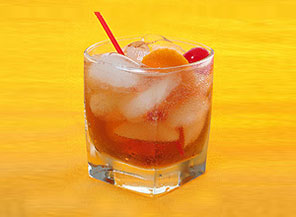Cocktails courtesy of Margaret Yardley Potter with a digression to water ice.
 Mrs. Potter enjoyed a drink, rather too many in fact, and includes a chapter on cocktails in At Home on the Range, her delightful 1947 cookbook. The book is timebound only in the sense that it addresses the sexist nature of the time, when the domestic bar was a male domain. She therefore entitled the chapter in question “Less Moaning at the Bar, Please” because “too much moaning still [went] on when the average female is confronted with the task of mixing and serving drinks.” (Potter 198)
Mrs. Potter enjoyed a drink, rather too many in fact, and includes a chapter on cocktails in At Home on the Range, her delightful 1947 cookbook. The book is timebound only in the sense that it addresses the sexist nature of the time, when the domestic bar was a male domain. She therefore entitled the chapter in question “Less Moaning at the Bar, Please” because “too much moaning still [went] on when the average female is confronted with the task of mixing and serving drinks.” (Potter 198)
The approach is classic Potter. She refuses to play victim, chides those who do and offers her reader encouragement as well as instruction in the forbidden art. It is for Mrs. Potter simply a question of common sense;
“when the hostess lives alone and likes it or the host is delayed beyond the arrival of the guests, any halfway intelligent woman should be able to produce a drinkable cocktail, for no matter how men delight in making the mixing mysterious, a dry martini, for instance, takes even less time and much less skill than baking a plain cake, and no loss of femininity ever follows the discovery that the contents of the cook’s frosty shaker are palatable.” (Potter 198)
And besides, courage and confidence have their own self-promotional reward in “the assurance that the meal to follow will be even more delicious than expected.” (Potter 198)
After a few preliminary warnings--buy plain glasses rather than something that resembles “the Goddess of Liberty bearing a colored bowl on her head,” measure, get lots of ice and go easy on garnishes--Mrs. Potter sounds the charge: “Attention, female bartenders! Let’s go.” (Potter 199) She traverses the familiar terrain of Manhattans, Martinis and the like, but our interest lies in quirkier turf.
 We do not know why we never thought to make a Rum Old Fashioned but Mrs. Potter found them onboard a British steamer in the Caribbean. She makes hers with light rum, which we dislike, although the Old Fashioneds sampled on shipboard had a base of Rhum Martinique; that could have been amber or dark. This is, as she claims, a “most refreshing drink for a hot evening” so choose an amber rum like Mount Gay, its ‘Sugar Cane Rum’ if you can find some, and use simple syrup instead of the sugar and water Mrs. Potter describes.
We do not know why we never thought to make a Rum Old Fashioned but Mrs. Potter found them onboard a British steamer in the Caribbean. She makes hers with light rum, which we dislike, although the Old Fashioneds sampled on shipboard had a base of Rhum Martinique; that could have been amber or dark. This is, as she claims, a “most refreshing drink for a hot evening” so choose an amber rum like Mount Gay, its ‘Sugar Cane Rum’ if you can find some, and use simple syrup instead of the sugar and water Mrs. Potter describes.
You will want to combine about 2 teaspoons of the simple syrup with a jigger of rum and dash of bitters; for this purpose Angostura rather than one of the newfound artisanal ones is best. Stir things together, plunk down some ice (“2 or 3 chunks;” not too much) and squeeze in a wedge of lime or simply a twist (Mrs. Potter’s original preference). “These are,” she warns, “best not attempted in bulk.” (Potter 200)
“Sherry or gin ‘and’” Mrs. Potter describes as “English apertifs.” They use Angostura too and little else; readers may know with a version of one of them as pink gin, which had been the potent sundowner of choice in British East Africa. We recommend chilled rather than warm Sherry (from the fridge) or gin (from the freezer) but otherwise would not dare alter her directions:
“Put a good dash of Angostura bitters in a sherry glass and roll it around until the inside is thoroughly coated. Drain out any drops that remain and fill the glass with gin or dry sherry. A twist of lemon peel is an optional garnish…. ” (Potter 204)
Purists or admirers of Empire will want a tumbler for the gin and while Mrs. Potter does not say so, the treatment works with Rainwater Madeira (a Verdelho or Sercial is too good on its own).
 Punches deserve revival and Mrs. Potter’s are good. They sound (and taste) much like eighteenth century British combinations inspired by the Caribbean Station. Champagne punch is simple, and cheap if you use a decent Cava or California sparkler instead of the real deal. All you do is pour half a cup of brandy per quart of ‘Champagne’ into a punchbowl over a big block of frozen orange juice. Do not add Mrs. Potter’s “optional bottle of Sauternes; expensive, also better alone and it cloys the punch.
Punches deserve revival and Mrs. Potter’s are good. They sound (and taste) much like eighteenth century British combinations inspired by the Caribbean Station. Champagne punch is simple, and cheap if you use a decent Cava or California sparkler instead of the real deal. All you do is pour half a cup of brandy per quart of ‘Champagne’ into a punchbowl over a big block of frozen orange juice. Do not add Mrs. Potter’s “optional bottle of Sauternes; expensive, also better alone and it cloys the punch.
If, however, you have a sweeter tooth, then take her advice and use frozen “water ice” instead of juice. For the uninitiated, water ice is a Philadelphia incarnation of what normal people call Italian Ice and New Orleanians called a SnoBall. It basically is crushed ice saturated with flavored syrup, usually but not always, at least not in New Orleans, of fruit. It will require a sojourn in the freezer to firm sufficiently to become a bed for your punch.
Fish House Punch sports a better name, can claim a more authentic pedigree and packs an insidious proverbial wallop. It is, as Mrs. Potter avers, “without a peer in this category.” (Potter 201) It is the kind of thing that gave Port Royal its fearsome reputation for hard living before the fall. Once again we prefer simple syrup to mixing your own sugar and water, and use considerably less than the palate of 1947 would have preferred.
Let stand, “in a corked demijohn” overnight:
-1 quart decent brandy
-1 quart strained fresh lemon juice or a mixture of lemon and lime
- ½ cup peach brandy
-2 quarts “Jamaica rum” (homage to Port Royal; Coruba is ideal, Meyers will do)
-2 more of water
-the simple syrup to taste; to ours, about a cup
Just before the debauchery begins, set a block of ice (an empty half gallon juice or milk carton makes a handy mold) in the punch bowl and pour on the fish house brew.
If you unaccountably lack a demijohn, any big nonreactive container will do, even a trashbag draped inside a metal pot.
The enterprise of Fish House Punch bears with it a potential reward as well as risk, exemplified by Mrs. Potter in the unPC tale of an apocryphal aunt. It may or may not be best to
“keep a watchful eye on any rich unsophisticated maiden aunt’s trips to the source of supply, for while with her second cup she may well begin writing checks in your favor for astronomical amounts, after the third or fourth beaker her illegible signature is later to leave the way open for later unjustified charges of forgery. Facing possible results cheerfully, proceed with the mixing.” (Potter 201)
Then there is “Guadalcanal Pigeons Milk.” The Potters found the drink at a bar in the “New Jersey Barrens” that promised it “restores Vitality and increases Productiveness.” To make it, combine half a jigger each of brandy and rum (Mrs. Potter does not specify but choose something dark like Meyers) with a cup of milk, a raw egg, teaspoon of sugar and “2 or 3 big pieces of ice.” Shake it all up, strain and serve.
Mrs. Potter considers the drink an “important addition to our country’s history…. And while its qualities don’t entirely live up to the original advertisement, its quaffing is nevertheless nourishing and refreshing.” (Potter 203)
Finally for now, something strange, nonalcoholic or not, and good. Mrs. Potter made her own raspberry vinegar to mix with sparkling water on a hot hot day. You need not go to the trouble today when raspberry vinegar stands on the shelf at just about every supermarket. Pour a jigger of vinega into a tall glass over ice, add a jolt of vodka and fill the glass with your sparkling water of choice. Bracing.
For more on the lost city of Port Royal, Jamaica, consult “Outlaw elements & culinary adaptation: Some peculiarities of Jamaican history and its food” at bfia Number 20 from September 2011 in our archive.

